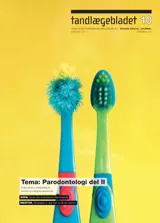Behandling af kronisk parodontitis
Den kroniske parodontitis er den hyppigst forekommende marginale parodontitissygdom og som sådan en tilstand, som langt de fleste behandlere ofte skal tage stilling til. Nærværende artikel beskriver den sekvensvise behandling heraf. Behandlingen er årsagsrelateret, dvs. rettet imod den ætiologiske faktor, som er de parodontale patogene mikroorganismer i de bløde og hårde belægninger på tænderne. Behandlingen indeholder grundig – men ikke overdreven – bearbejdning af rodoverfladen ved en såkaldt lukket eller non-kirurgisk depuration. Til dette formål kan anvendes forskellige instrumenter, men kun anvendelsen af håndinstrumenter og ultralydsinstrumenter beskrives. I de tilfælde, hvor den lukkede depuration ikke har tilvejebragt inflammationsfrie forhold, kan en åben depuration i form af et parodontalkirurgisk indgreb komme på tale. For at undgå en reinfektion og videre progression af den kroniske parodontitis er placeringen af patienten i et livslangt regelmæssigt vedligeholdelsesprogram af største betydning.
Therapy for chronic periodontitis
Chronic periodontitis is the most commonly occurring form of periodontitis, and as such, a condition which the entire dental team will meet on a regular basis. This article describes the various phases in the treatment of chronic periodontitis. Current treatment is cause-related and therefore directed towards the periopathogenic microorganisms in the soft and hard deposits on the teeth. The treatment includes a thorough but not excessive mechanical debridement of the involved root surfaces, so called closed or nonsurgical scaling and root planing. For this purpose different instruments can be used, but only the use of handinstruments and ultrasonic instruments is described herein. In those cases where nonsurgical therapy does not result in resolution of the inflammation, surgical therapy in the form of open debridement can be used. To maintain the result after treatment and to avoid reinfection, the enrollment of the patient in a wellorganized maintenance program is of the utmost importance.


